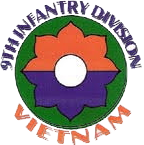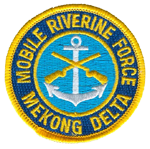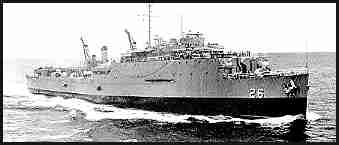
USS Tortuga (LSD-26)

The USS Tortuga LSD (26) sailed for Vietnamese waters on 1 March 1966, arrived at Vung Tau on 18 April, and relieved Belle Grove (LSD-2) as support ship for “Game Warden” — the Navy’s operation designed to interdict the flow of communist supplies along the coastlines of South Vietnam. Initially, Tortuga operated in the Rung Sat Special Zone between Saigon and Vung Tau helping to guard the entrance to the shipping channels snaking through Viet Cong territory to the capital city.
Tortuga shifted to the Mekong Delta region on 12 June to serve as a floating base for the Navy’s fast PBR’s of Task Force 116 and for a detachment of Army Bell UH-1B Huey helicopter gunships. The PBR’s attached to River Patrol Squadron 512, were small yet relatively heavily armed craft. Each mounted a .60-caliber machine gun forward and an “over-and-under” combination mount of one .50-caliber machine gun mounted over an 81-millimeter mortar aft. The helicopters, too, were relatively heavily armed, packing a “punch” of rockets of varying sizes and up to six machine guns. Initially the helicopters were Army “choppers” from the 145th Aviation Detachment. However, by the end of Tortuga’s tour they were Navy aircraft from Helicopter Attack (Light) 3. Together, the PBR’s and Hueys conducted their patrols and forays into the verdant jungle waterways, the PBR’s knifing through the muddy sandy-colored waterways while the helicopters flew close cover above.
Occasionally, the hard-hitting teams would strike “pay-dirt,” by capturing enemy munitions. On one occasion, on 12 June at the mouth of the Co Chien River, Tortuga’s PBR’s participated in the capture of a large stock of guns and munitions captured from a damaged communist trawler which had been forced aground and set afire.
During her support operations with the riverine assault groups, Tortuga received a number of distinguished visitors ranging from General William C. Westmoreland, Commander, Military Assistance Group, Rear Admiral N. G. Ward, Commanding Naval Forces Vietnam; as well as United States Ambassador to South Vietnam Henry Cabot Lodge; and news commentator Chet Huntley, who brought with him an NBC camera team to record a news story on Tortuga’s river patrol base activities.
Her deployment completed in the summer of 1966 Tortuga got underway on 30 August and steamed via Japan to the west coast. She arrived at San Diego on 7 November for leave, upkeep, and overhaul. The refit lasted through April of 1967, modernizing the ship and preparing her for another WestPac deployment. Following a period of refresher training and amphibious exercises, Tortuga sailed on 21 July 1967 from San Diego and arrived, via Hawaii, Guam, and the Philippines, at Danang on 5 September.
Upon arrival, Tortuga relieved Monticello (LSD-34) with Amphibious Ready Group (ARG) “Bravo” and operated with that unit into the fall of 1967. She took part in Operations “Fortress Sentry” and “Formation Leader”, before her detachment from ARG “B” on 9 November. Subsequently, Tortuga loaded a cargo of disabled or damaged CH-46 helicopters for transport from Danang to Okinawa, where the “choppers” were repaired for further service. For the remainder of the year, from 3 to 31 December, Tortuga conducted cargo lifts from Japanese ports to Vietnam and vice-versa.
Tortuga then returned to the west coast via Yokosuka, Buckner Bay, Subic Bay, Hong Kong, and Pearl Harbor — and arrived at Long Beach on 9 March 1968. For the remainder of the year, the landing ship conducted exercises and local operations out of Long Beach until again deploying to WestPac in February 1969. On 17 February, while en route to Yokosuka, Tortuga conducted her first underway refueling with Cook (LPR-130) — receiving 31,000 gallons of Navy Special Fuel Oil (NSFO). Upon arrival at Yokosuka, Tortuga’s in-port time was extended to allow the on-loading of a complete destroyer radar system for transport to Subic Bay. Underway on 11 March with her special cargo, the landing ship soon reached Subic Bay, unloaded, and proceeded for Kaohsiung, Taiwan, en route to South Vietnam.
On the last leg of her Vietnam-bound voyage, Tortuga instituted a stepped-up shipboard defense program consisting of daily general quarters drills, exercising especially with the ship’s guns and in damage control problems — for the ship had received intelligence reports that a Viet Cong rocket attack was expected to coincide with her arrival at Danang. When paraflares were sighted on the horizon at 0200 on 14 March, Tortuga knew that she had arrived at her destination and went to general quarters. The expected attack failed to materialize, though, and Tortuga unloaded her cargo unmolested but at piers which, only the day before, had been rocketed by the Viet Cong. When the offloading was completed, Tortuga shifted her berth far away from most of the shipping in the harbor. There boat crews bent to the task of loading old ammunition on the ship. Meanwhile, one boat crew, composed of one officer and five enlisted men, armed with rifles and Thompson submachine guns, kept a constant vigil in an LCVP which circled the ship at a distance of 60-70 yards. Periodically, at odd intervals, the boat’s crew would drop concussion grenades in the water in an effort calculated to discourage enemy frogmen. When the task was completed, the ship got underway for the Philippines.
Reaching Subic Bay after an uneventful passage, the ship unloaded the explosives and soon received orders to transport a much-needed suction dredge up the Saigon River to Nha Be, through territory largely controlled by the Viet Cong. At Tan My, Tortuga embarked the dredge and a warping tug and got underway. During the transit of the Saigon River, the landing ship stood to general quarters, keeping a sharp eye for enemy attempts to impede the progress of the ship. The enemy failed to appear, however, and Tortuga, her dredge, and her tug arrived at Nha Be soon thereafter.
From 5 to 20 May, Tortuga participated in “Daring Rebel”, an operation mounted to seek out and destroy Viet Cong rest camps on Barrier Island, 15 miles south of Danang. Joining Duluth (LSD-6), Winston (LKA-97) and Okinawa (LPH-3), Tortuga closed the beachhead, while White River (LSMR-536) stood offshore to provide initial bombardment. When White River launched a heavy rocket barrage shoreward, “Daring Rebel” got underway. Landing craft splashed ashore while troop-carrying helicopters quickly airlifted troops ashore in the vertical envelopment phase of the operation. For the next two weeks, Tortuga served as primary control ship for the operation which located and destroyed caches of food and ammunition and Viet Cong rest camps.
The landing ship again served as primary control ship (PCS) in Danang harbor during “Gallant Leader”, a follow-up to “Daring Rebel”. Relieved by Duluth on 23 May, Tortuga set sail soon thereafter for Buckner Bay and simulated combat landings during exercises with Assault Craft Unit 1 in late June. In July, Tortuga transported the first increment of marines and their equipment for “Keystone Eagle”, from Cua Vet, South Vietnam, to White Beach, Okinawa, before returning up the Saigon River to Nha Be with a load of palletized cargo.
Subsequently supporting Operation “Sea Float”, delivering two pontoons and 32 pallets of ammunition from Nha Be to Tan My, Tortuga onloaded men and equipment from “Charlie” Battery, 1st Light Antiaircraft Missile Battalion (LAAM), First Marine Air Wing, at Danang harbor for transport to the west coast of the United States. In this last operation, the second increment of “Keystone Eagle”, Tortuga headed “stateside” for the last time, and arrived at Seal Beach, Calif. on 12 September 1969, unloading the 58 Hawk missiles of the 1st LAAM Battalion, USMC, and then proceeding to the Long Beach Naval Shipyard.
Tortuga disembarked her marines and proceeded to pier 7 where she was moored outboard of Carter Hall (LSD-3). On 3 January 1970, Tortuga got underway for the Inactivation Facility at Mare Island, where she was decommissioned on 26 January 1970. Transferred to the temporary custody of the Maritime Administration (MARAD) on 6 October 1970, the ship was berthed at Suisun Bay, Calif., where she was later placed in permanent custody of MARAD on 1 September 1971. She was carried on the Navy list into 1977. Her name then disappeared from the list.
Awards earned during the Vietnam War: Navy Unit Commendation, RVN Gallantry Cross with Palm, RVN Campaign Medal with 60’s device and the Vietnam Service Medal with (8) Battle Stars.
Unofficial Vietnam history thanks to Chuck Westbrook. His site is HERE.

